| Spectrum Software Scene |
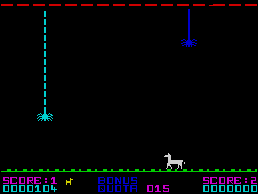
META-GALACTIC Llamas Battle at the Edge of Time, from Salamander Software, is a reasonably simple game with an extremely long and inventive name. Like the name, the game, for the 48K Spectrum, is inventive and its simplicity is deceptive. You will find that as soon as you start playing you are hooked.
The hero is an alien llama which destroys swarms of creatures which look like spiders, as they abseil lengths of web ready to kill you if you touch them.
When you fire at the spiders your laser bolts will bounce off a force field at the top of the screen. You can lower the field as the spiders descend so that you can find the correct angle for the shot. If you hit a spider's web-cable the creature will fall and turn into a worm which tracks you along the ground. If it touches you one of your llama lives will be lost. The skill involved in the game is to hit the spiders while they are still in the air.
Once you have passed a level you can proceed to the next which is faster and contains more spiders. If you are feeling really masochistic you could start at a more advanced level.
Meta-Galactic Llamas is a Jeff Minter game and as such was meant originally for the Commodore computers.
For that reason the game is not so good as the original. It is still, however, a very impressive game although the graphics are not stunning and the sound is nothing to rave about. Minter, with the help of programmer Chris Clark, has gone for originality and addiction instead of the things which usually make a good Spectrum game.
| META-GALACTIC LLAMAS BATTLE AT THE EDGE OF TIME | Memory: 48K | Price: £6.95 | Joystick: Programmable | Gilbert Factor: 8 |
THE IDEA of presenting a carnival shooting gallery as a computer game would be interesting and the software would sell in great numbers so long as it was programmed in a moderately competent manner.
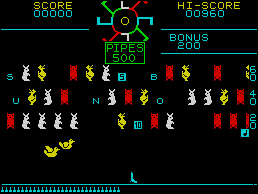
Carnival, for the 48K Spectrum, succeeds on the first point but fails miserably on the second. The game involves shooting ducks, owls and rabbits as they move across the shooting rank. You must be wary of the ducks which can swoop and take some of your limited number of bullets.
The bullets can be replaced by shooting a square card which moves with the animals and contains the bonus number of bullets.
The letters b-o-n-u-s also travel round the range and you should shoot them to obtain extra points. If you hit the pipes which spin round at the top of the screen like a windmill you will also get more points.
Points may win prizes but not so far as Carnival is concerned. The graphics are only just presentable and they flicker during animation. The game could have been written as easily in 16K with Basic - it certainly looks as if it has been.
The idea of Carnival is good but more time could have been spent programming it.
If a better version is produced, by all means buy it but we do not recommend Carnival even for children. It can be obtained from Eclipse Software, London.
| CARNIVAL | Memory: 48K | Price: £6.45 | Joystick: Kempston ZX Interface | Gilbert Factor: 5 |
IT WILL take several months of play to reach your target in Millionaire for the 48K Spectrum from Incentive Software. The idea is to start a software house and then either sell your products to other companies for them to market or sell directly to the retail trade. The problem is that the scales of success incorporated into the game are such that it will take a long time to get anywhere near a million pounds or dollars in profit.
During the game you can specialise in a specific type of software and you have to tell the program which qualities you desire most in a product. You will then be informed of your current financial position, depending on how well your software is selling and the amount you have had to pay in bills.
Unfortunately you cannot make large profits quickly because of the low limit to numbers of program copies you can make by duplication. Another difficulty is that the game relies heavily on luck. You may put in one set of figures during one session and then enter them again during the next session and have completely different results.
Despite the minor flaws in the program, Millionaire is one of the few addictive strategy games on the market. You may not become a millionaire or learn how to handle the business of a software house but you should find the experience engrossing.
| MILLIONAIRE | Memory: 48K | Price: £5.50 | Gilbert Factor: 7 |
SINCLAIR RESEARCH is continuing its policy of marketing games under licence with four new releases. Zipper Flipper by R-E-D Sunshine is a pinball program with a fruit machine feature included. You have to break down a wall of bricks with the ball to bring the fruit machine into play.
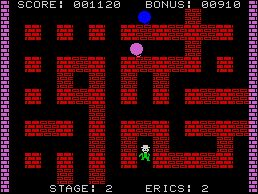
The other three games are all by Hudsonsoft. Driller Tanks, which sounds like a video nasty, is a simple game of underground warfare, as you use your tank to prevent marauding monsters tunnelling to the surface.
Bubble Blaster is a slightly more interesting program in which you must burst bubbles with a ray gun before they land on you.
Those three games all suffer from a very simple concept which has not been developed to provide any real variety during the play. The graphics on Bubble Blaster, though they could be better yet, are of higher quality than in the other two programs but are also the least complex when seen on the screen, even though they may be well-programmed.
The fourth in the series, Eric and the Floaters, is clearly superior to the other three. Eric is attempting to explore a lost underground civilisation by planting bombs in a network of tunnels to clear blockages and reveal treasures.
He is pursued by balloon-like Floaters, which also have to be killed with the bombs. The concept is again simple but in this case there are a number of hidden surprises which increase the enjoyment for the player out of all proportion to the extra trouble taken to program the refinements.
To play the games with a joystick you will have to use Interface Two, or one of the programmable interfaces, as Sinclair is clearly not interested in supporting peripherals manufactured by other companies.
| ERIC AND THE FLOATERS | Memory: 48K | Price: £5.95 | Joystick: Interface 2 | Gilbert Factor: 6 |
| ZIPPER FLIPPER | Memory: 48K | Price: £5.95 | Joystick: Interface 2 | Gilbert Factor: 4 |
| DRILLER TANKS | Memory: 48K | Price: £5.95 | Joystick: Interface 2 | Gilbert Factor: 3 |
| BUBBLE BLASTER | Memory: 48K | Price: £5.95 | Joystick: Interface 2 | Gilbert Factor: 5 |
ANYONE who likes fast action unsullied by graphics or any form of storyline will enjoy Centipoid Plus 3 from Orwin Software. As the name indicates, it is another spin-off of that old favourite Centipede. There are no instructions on the cassette insert but detailed explanations on-screen show which nasties are to be avoided and how many points can be scored by destroying them. There are six stages to the game and scoring 100 points on one stage will lead you to the next. You receive a bonus for completing a stage in good time and a minimum score of 500 points takes you to the high score table.
Although the graphics are simple, to put it mildly, that does not matter too much as you will probably be too busy firing and avoiding enemy bullets to notice. Facilities such as being able to define your own keys, choose the stage at which you want to start, and to adopt an auto-fire facility make this a thoroughly playable if not sophisticated or original game.
| CENTIPOID PLUS 3 | Memory: 48K | Price: £5.95 | Gilbert Factor: 5 |
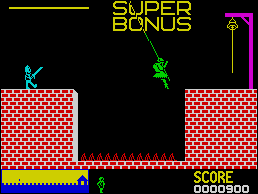
ENTHUSIASTS for the popular amusement arcade game Hunchback will enjoy the version from Ocean Software. You are Quasimodo, the notorious Hunchback of Notre Dame, who in legend rang the bells of the famous cathedral. In the game you have to rescue your sweetheart Esmerelda, who is imprisoned in a tower on the cathedral battlements. You perform the selfless deed by leaping over fireballs, swinging on ropes and ringing the bells, pursued all the time by a tenacious French soldier.
The game as released is a more or less direct copy of the original arcade game, which makes it simple in design but at the same time a sure winner with those who have unloaded a fortune in 10 pence pieces in dingy halls of pleasure. There are 15 screens but they lack the variety of many arcade games, being based on three or four basic configurations with added hazards at the later stages. On the plus side, the game is challenging but very easy to play and also addictive.
Graphics are competent if not awe-inspiring. Quasimodo is a respectable size, which makes a change from some of the tiny stick-figures which feature in some games. The main difficulty with the graphics is that old Spectrum chestnut of how to prevent the colours spilling over when one colour overwrites another.
In Hunchback, as an example when the green Quasimodo falls to his doom, sections of the red wall also turn green momentarily. That was less of a fault previously than it appears now, with companies like Ultimate and Software Projects producing games which apparently solve the problem.
The action is pacy but not so fast that it discourages the less nimble-fingered among us. Timing rather than sheer speed is the secret of success in Hunchback.
Ocean has produced a game which, although it does not dazzle the eye or numb the brain with its complexity and design, is nevertheless a good, solid version of an arcade classic.
| HUNCHBACK | Memory: 48K | Price: £6.90 | Joystick: Kempston, Protek, Sinclair | Gilbert Factor: 7 |
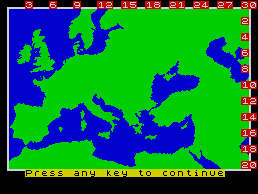
IN CONQUEST, from newcomer Cheetahsoft you have to conquer a sizeable portion of Europe and the Mediterranean. You start as emperor at the head of one legion and, beginning from your capital city, you set out to triumph, conquering whatever you pass over. As your territory expands it can support more legions and the empire grows apace.
The game has five levels, the first few serving as introductory modes. In the full game barbarians will attack the fringes of the empire, plague may decimate the land, rival empires rise to challenge you, and your subordinate generals may revolt if they become too powerful, plunging your people into civil war.
The representation of the map is very impressive and the structure of the game has been thoughtfully worked out to provide a real challenge, as well as a sense of genuine participation in great events.
The biggest disadvantage to the game is that it is very slow, as much of the program is written in Basic. While that does not affect your moves too much, as you need to think about them carefully, the other operations, such as the action of the plague or the barbarian attacks, are painfully long-winded.
Cheetahsoft appears to recognise there is a problem, as the program instructions exhort the player to persevere and try the full game before making a judgement. It would be better by far to have written the game in full machine code to avoid the possibility altogether.
None of those faults, however, renders the game unplayable. If you succeed in controlling an empire of 100 squares on the map, your performance will be assessed in comparison with great imperialists of the past.
We recommend Conquest to lovers of strategy games with a sympathy for the problems of Attila the Hun or Napoleon but the rating must reflect the fact that many people will be disappointed by the slow response time and fussy graphics.
| CONQUEST | Memory: 48K | Price: £6.95 | Gilbert Factor: 6 |
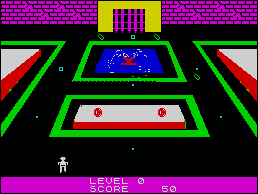
DESPITE its original name, Psi-Spy for the 48K Spectrum is an unoriginal arcade adventure game. The object of the quest is first rings of power and then keys which can be found in the Dungeon of Zar. To get them you have to read the instructions several times - and try to move your character round the screens filled with uninspiring square monsters which look as if they have fallen from the Spectrum User Manual.
The approach to the dungeon, where you have to pick up several rings to enter and produce some kind of score, takes the computer almost a minute to set up using its colour-filling algorithms.
The game is an adventure of discovery as you will continue to find new keys to press the further you proceed. To be fair, the plot has some depth as you have to interrogate guardians of the keys using a mind probe and press various keys to decide whether to eat, take or pay for objects.
Psi-Spy would have been original and interesting a year ago but it looks too much like a cross between Black Crystal from Carnell and Manic Miner from Software Projects for comfort. If you want another dungeons game with average graphics, the game is for you. It can be obtained from Postern, Glos.
| PSI-SPY | Memory: 48K | Price: £7.95 | Gilbert Factor: 5 |
FOR ONCE you do not have to save the world - merely your own unlovely hide, battling hordes of mutants in the stadium of the future.
The game is a matter of killing as many foes as possible while moving round the rectangular arena. When you clear a screen, a new wave of mutants appears. The only mildly original twist is that the arena begins to shrink as the game progresses.
Nor is it the fastest arcade game in existence, particularly if you want to fire continuously.
Arena 3000 may appeal to those who believe that just because you have six legs or a green torso you deserve to be obliterated but there are no obvious miracles of programming to justify Microdeal producing yet another such game.
| ARENA 3000 | Memory: 48K | Price: £5.50 | Joystick: Kempston, Sinclair, Cursor | Gilbert Factor: 5 |
VEGA-TABLE is a program designed to help amateur gardeners get the most out of their vegetable plot by allowing you to plan the year's crops. There is a set of commands allowing you to define the size of your plot, dividing it into three separate areas for the purposes of crop rotation.
You can then decide when and what to plant in each area and the screen display shows the number of plants suitable for that row and indicates the correct distance apart for planting. The program produces a calendar showing when you should expect to be harvesting the crop and what yield you should achieve - slugs and the weather permitting.
Vega has included a list of the vegetables and details of each one. There are 42 in all and most of the standard varieties are included. The program should appeal most to the armchair gardener who loves to spend hours with seed catalogues planning an assault on the barren earth. It is easy to use and the graphics are reasonably attractive. If only it were as easy to produce the best broccoli in real life.
| VEGA-TABLE | Memory: 48K | Price: £6.75 | Gilbert Factor: 7 |